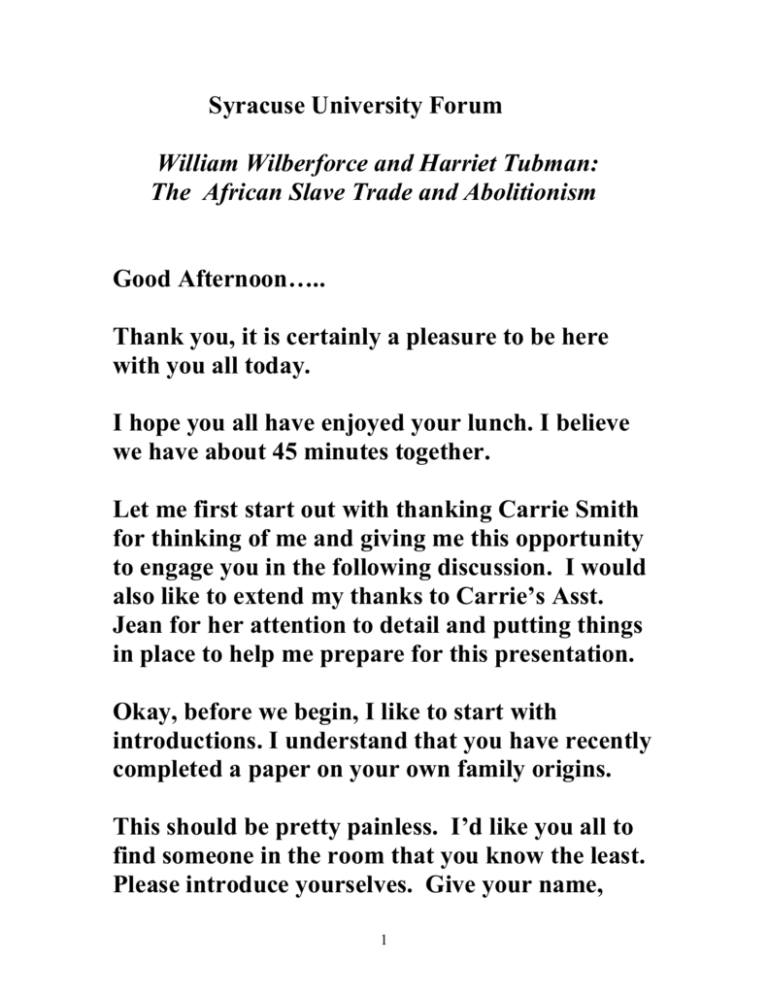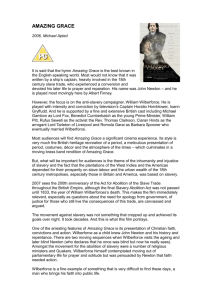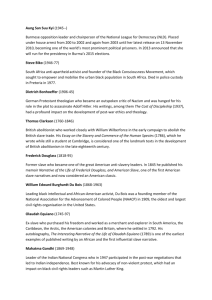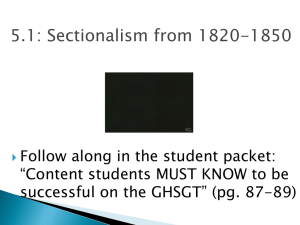Syracuse University Forum William Wilberforce and Harriet Tubman
advertisement

Syracuse University Forum William Wilberforce and Harriet Tubman: The African Slave Trade and Abolitionism Good Afternoon….. Thank you, it is certainly a pleasure to be here with you all today. I hope you all have enjoyed your lunch. I believe we have about 45 minutes together. Let me first start out with thanking Carrie Smith for thinking of me and giving me this opportunity to engage you in the following discussion. I would also like to extend my thanks to Carrie’s Asst. Jean for her attention to detail and putting things in place to help me prepare for this presentation. Okay, before we begin, I like to start with introductions. I understand that you have recently completed a paper on your own family origins. This should be pretty painless. I’d like you all to find someone in the room that you know the least. Please introduce yourselves. Give your name, 1 major or area of study, family origin, and one NEW thing you found out as a result of your family research. For how many of you was that easy? For how many was that hard? Can we have one volunteer who will tell us why that was easy? Can we have one person tell us why that was hard? From the work that I have done with DIVERSITY TRAINING, we find that some families value sharing ideas and feelings with others. There are other families that are less prone to do so. So there is really no right or wrong approach, it is a matter of the values we are raised with. Can we have one VOLUNTEER to take one minute to share their FAMILY ORIGIN and ONE NEW THING THAT YOU FOUND OUT as a result of doing their research? A VOLUNTEER SPEAKS/SHARES. Thank you so much for sharing with us. We appreciate that. Let’s show our appreciation. 2 By now, we all have had a chance to view the documentary, AMAZING GRACE. It was quite compelling. There are a number of lessons to be learned from the work and passion of William Wilberforce. We now know that William Wilberforce was the man behind the movement to abolish the AFRICAN SLAVE TRADE in the Britain Empire. AMAZING GRACE shows us that one man or one woman can make a powerful difference in the lives of people who are disenfranchised, oppressed and enslaved. William Wilberforce was the one who gave voice to those who were enslaved for generations. He was the man who changed the trajectory of history. His accomplishment was not achieved without struggle, without massive resistance and to some extent without political manipulation. Even William would admit that his long, hardwon success was not possible without his supporters and allies. We will find that in these 3 kinds of transformational endeavors no man is an island. William had his wife, Barbara; his university friend William Pitt who would become the youngest Prime Minister; another friend, Clarkson; Equianos- the former slave; and his friend and minister, John Newton, the former slave trader who penned the words to beautiful song, AMAZING GRACE. But I digress for a moment. I believe that the greatness of this man and the greatness of his accomplishment must be seen within the context of the HISTORY OF SLAVERY. Prior to the work of William Wilberforce, a member of the British Parliament, slavery persisted and was maintained as the status quo in some form all across the world. Millions of people… Africans, Europeans, Asians, Indians, Middle Easterners, Jews, Aborigines, Alaskans … were born and died in servitude to another human being. What took William Wilberforce to accomplish in nearly twenty years, could not be achieved in over two thousand years of slavery, indentured 4 servitude, contract labor, serfdom or caste systems from across the world. Yes, perhaps it was time. And Yes, William Wilberforce gave voice to the enslaved people. He gave voice to the Africans who the slave traders could not hear, who the merchants could not hear, who the masters could not hear and who the British Parliament could not hear. Yet, slavery did not begin or end with the African Slave Trade. It began well before the Portuguese, the Dutch and the British brought their ships to the shores of central and western Africa looking for human cargo. In recent historical times, we tend to think of Africans when we think of slavery, but history tells us that slavery existed in ancient times. From the beginnings of human civilization, man captured and relegated fellowmen into a brutal, horrendous life of bondage. Slavery, indentured servitude, contract labor, serfdom, and the caste system were not reserved for black people only. Human bondage knew no discrimination. 5 From the earliest of times, there has been a top down human hierarchy within tribal, religious, ethnic and racial societies in every corner of the globe. This hierarchy defined where each individual belonged within a specific society. This human bondage hierarchy found itself amidst the Egyptians, Romans, Australians, Japanese, Africans, Alaskans, and in England, Ireland, the Caribbean, South America, Medieval Europe, India, Asia and the Middle East. One has to ask oneself, how does a society justify human bondage, slavery or human rights violations in whatever form it takes? According to many historians, it turns out that it was a simple matter of creating a labor force that received little or no compensation for their work. As the ancient and European empires grew beyond their own borders, they needed more bodies to make, grow and harvest goods. The greed and wealth of the upper classes or upper castes, demanded that the defenseless masses would create wealth for them under severe brutalization, fear, and death. Inevitably, the rich became richer, and the poor became poorer. 6 In biblical times, the Egyptians enslaved the Jews. From daylight to dusk, thousands of Jews were made to stomp mud and straw with their feet to make clay for the bricks that were used to build the mansions for the royalty and homes for the masters and military officials. The women were enslaved and selected to satisfy the sexual pleasure of wealthy men or the land barons that chose her. Fathers and would-be husbands, were left to grieve the loss of their young daughters and wives-to-be. Families were separated and devastated. The Roman slaves and the serfs of the High Middle Ages were no better off. They were bound legally, economically and socially to the landowners and nobles. They not only worked the fields, but in mining, forestry, land and river based transportation, military, and crafts. The greatness of a land baron was measured by the number of ”souls” that he owned. Similar forms of feudalism were evident in Spain, Ancient Mesopotamia, China, Japan and Muslim India. 7 Slavery and serfdom were prevailing human conditions. The severity or degree of brutality and inhumane treatment may have varied from geographic location to geographic location, but the men, women and children who were faced with the reality of a LIFE SENTENCE to the rigors and humiliation of human bondage could not escape it. Can you imagine yourself, your parents and siblings, your children, grandchildren, and great grandchildren and your descendants beyond being faced with the reality that the simple provisions of food, clothing and shelter would be hard earned from a legacy of slavery, serfdom, servitude or labor barely compensated? In America and Britain, and most of the civilized world, we can not imagine it. Yet slavery, serfdom, servitude and labor not fairly compensated are our legacy and history. Each of us is touched by them in some way, either directly or indirectly. We only need to look back at our own family origins. To a great extent our family origins help to shape our understanding of ourselves and how we relate to the world. ******* 8 This was no less the case for William Wilberforce. Wilberforce was born into this world as a sickly child and nearly blind in 1759. He was a son of a wealthy merchant. His father died when William was nine years of age. For a time he was raised by relatives who were staunch supporters of John Wesley of the Methodist Movement. Religion weighed heavily in the development of the young William. In his twenties, he converted to Evangelical Christianity. As a young man, he grew to cling to the stories and sermons of a frequent guest minister, The Reverend John Newton. William would later write, “I revered him as a parent when I was a child.” Reverend John Newton had been the captain of a slave ship. He later denounced the slave trade and became a great influence in its eradication. He considered the slave trade unlawful and wrong. A decade before his death, he said, “… we are delaying from year to year to put a stop to our part in it, the blood of the many thousands of our 9 helpless, much injured fellow creatures is crying against us”. These words and sentiments rang loudly in the ears of a young William Wilberforce. If you recall, John Newton was the old man in the documentary that was barefooted mopping the floors in the church. He tells William that he is writing his account of the slave trade and wants William, “to damn them with it.” The blind John Newton suggests that he is haunted in his mind’s eye by 20,000 beautiful black faces. He can still hear their grunts and noises. He had visions on them corralled like animals in the bottom of his ship named the GREYHOUND. Years after he resigned his commission on the Greyhound, Newton wrote the words: Amazing Grace, how sweet the sound, That saved a wretch like me I once was lost, but now am found, Was blind but now I see. 10 Reverend Newton urges William to see the cause through. In the scene, Newton dismisses William to go and abolish slavery. Wilberforce was greatly concerned by what he perceived as the degeneracy of British society. With the encouragement and support of the Reverend, his wife, allies and anti slavery activists, William a Member of the British Parliament, and philanthropist, led the movement to abolish the slave trade. His voice was clear and he was a staunch advocate for the complete abolition of slavery from 1784 to 1826. Wilberforce committed over forty years of his life to a cause to bring human dignity and respect the oppressed Africans. William Wilberforce died three days after hearing of the passage of the Slavery Abolition Act of 1833. Finally, the resistance had also died. In his death, he, too, like the Reverend John Newton could bear witness to the AMAZING GRACE. ********** 11 The story of William Wilberforce is a great example of how family origin can shape a person’s passion and life’s work. We can see this same trend in the lives of abolitionists, here, in the United States. For those of you who have studied American Slavery, notably known as the PECULIAR INSTITUTION, will recognize the names of John Brown, Thomas Garrett, William Still, Fredrick Douglass, Sojourner Truth and Harriet Tubman Davis. If you were raised in Central New York, you may be familiar with the names of Gerritt Smith, Jeremiah Loguen, George and Rebecca Barnes, Madelyn Joselyn Gage, and William Seward. Some might say that Abraham Lincoln, the former president of the United States, the Great Emancipator, is the most well known abolitionist. But let us not forget the unnamed abolitionists, free blacks and whites, who were the station masters along the Underground Railroad, and provided food, clothing, shelter and safe havens for thousands of freedom seekers before the Great Emancipation. 12 Like William Wilberforce, each one of these abolitionists had a story. Each story was nurtured by their family origins and the historical era in which they were raised. From their religious, racial, humanitarian and political roots, they advocated for the freedom of the African slave. They all risked their lives, reputations and livelihoods for what they believed to be a Godgiven birthright. Every person was equal to the next, and no man had the right to make another his property. Of course, there were other debates about how ending slavery would level a devastating blow to the American economy, particularly in the Southern States. The question of the NEGRO did not always yield simply to moral grounds. The fiercest resistance came from the planters and plantation owners who derived their wealth from slave labor. They would not relinquish slave labor easily or without a fight. The American Civil War was a testament to that. Prior to and during the war, the abolitionists continued their movement to assist escaped slaves in their search for freedom. The Underground Railroad was the main gateway to freedom and 13 the Promised Land. By foot, waterways, horse and wagon, and train, freedom seekers traveled by night to reach Upstate, Central and Western New York, and Canada. My great, great grand Aunt Harriet was the most famous Conductor of the Underground Railroad. She was chestnut colored and stood about five feet tall. Her short stature betrayed her personal and physical strength, and her faith in God dwarfed both of those things. She escaped slavery on her own. She left Maryland to live as a free woman in Philadelphia. Aunt Harriet later moved to St. Catharines, Canada to live free beyond the reaches of the Fugitive Slave Law. Several years later, she returned to the South to rescue her family. She was also known to make numerous journeys to the South to rescue hundreds of freedom seekers and bring them north to Pennsylvania, New York, and Canada. Later, she bought a home in Auburn, New York from William Seward, Abraham Lincoln’s Secretary of State. Her home and property on South Street Road became a safe haven for family, friends and any black person who had fallen on bad times, who was ill or elderly. She firmly 14 believed that God would provide whatever was needed for them to survive. And He did. Unlike, William Wilberforce, Aunt Harriet was born a slave. She was not a politician or a philanthropist, but she was equally committed to abolish slavery. Harriet Tubman Davis answered the call of service and joined the Union Army. We believe she was the only woman to do so. She went behind enemy lines to bring Negroes out of the Confederate South. She then convinced scores of black men to don the uniform of the Union Troops and fight for the freedom that they deserved. There, at the Combahee River in South Carolina, she became known as General Tubman. She returned from the Civil War to her home on South St. Road. She married a Civil War veteran, Nelson Davis, who was twenty years younger than she. They had a good marriage and made a loving, safe and secure home for themselves and others. Uncle Nelson died of Tuberculosis after 20 years of marriage. Aunt Harriet was buried near his gravesite in the Fort Hill Cemetery. 15 Harriet Tubman Davis was referred to by everyone that knew her as Aunt Harriet. Black or white, she was everyone’s Aunt Harriet. Although she could not read or write and was not well spoken, she was a great story teller, and had a great sense of humor. And above all, she passed down to her relatives the importance of taking care of one another and helping others whenever possible. ********** So, the question might be asked of me, “How did the work of my famous great, great grand Aunt impact me?” Today, I believe that Aunt Harriet would be telling me: To become more aware of oppression and human rights violations in my community and the world, and do something about it. To move outside of my comfort zone to see and hear the stories of those who may need my help, And do something about it. To work within my faith community to do good for others. 16 To take care of my family, and to keep my home open for those who may need a helping hand. To keep the faith, and know if you are doing God’s work, he will provide. To be mindful that the vestiges of human rights violations persist, even today, and what are you doing about it. To my great, great grand Aunt Harriet it would all be about, “Don’t tell me what it is about, tell me about what you are doing to help”. Michele Jones Galvin Great, Great Grandniece of Harriet Tubman Syracuse University – Sims Hall April 21, 2009 17 18







